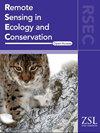如何利用车载移动监控图像和深度学习实现对野生动物的精确检测?
IF 4.3
2区 环境科学与生态学
Q1 ECOLOGY
引用次数: 0
摘要
随着人工智能(AI)技术的发展,车载移动监测系统已越来越多地融入到野生动物监测实践中。然而,通过这些系统捕捉到的图像往往存在分辨率低、目标尺寸小和部分遮挡等问题。因此,使用传统的深度学习网络检测动物目标具有挑战性。为了应对这些挑战,本文提出了一个增强型 YOLOv7 模型,简称为 YOLOv7(sr-sm),它集成了一个超分辨率(SR)重建模块和一个小目标优化模块。YOLOv7(sr-sm) 模型引入了超分辨率重建模块,该模块利用生成对抗网络 (GAN) 从模糊的动物图像中重建高分辨率细节。此外,YOLOv7 的 "颈部 "和 "头部 "集成了注意力机制,形成了小目标优化模块,从而增强了模型检测和定位密集小目标的能力。利用车载移动监测系统,在青藏高原捕捉到了四种野生动物类群--羊、鸟、鹿和羚羊的图像。这些图像与公开的高分辨率野生动物照片相结合,创建了一个野生动物测试数据集。我们在该数据集上进行了实验,将 YOLOv7(sr-sm) 模型与八种流行的物体检测模型进行了比较。结果表明,YOLOv7(sr-ssm)在精确度、召回率和平均精确度(mAP)方面都有显著提高,分别达到了 93.9%、92.1% 和 92.3%。此外,与新发布的 YOLOv8l 模型相比,YOLOv7(sr-sm) 在这三个指标上分别领先其 9.3%、2.1% 和 4.5%,同时还表现出更高的参数效率和推理速度。YOLOv7(sr-sm)模型架构可以准确定位和识别车载监控图像中模糊的动物目标,是移动监控系统中动物识别和计数的可靠工具。这些发现为在生物多样性保护工作中应用智能监测技术提供了重要的技术支持。本文章由计算机程序翻译,如有差异,请以英文原文为准。
How to achieve accurate wildlife detection by using vehicle‐mounted mobile monitoring images and deep learning?
With the advancement of artificial intelligence (AI) technologies, vehicle‐mounted mobile monitoring systems have become increasingly integrated into wildlife monitoring practices. However, images captured through these systems often present challenges such as low resolution, small target sizes, and partial occlusions. Consequently, detecting animal targets using conventional deep‐learning networks is challenging. To address these challenges, this paper presents an enhanced YOLOv7 model, referred to as YOLOv7(sr‐sm), which incorporates a super‐resolution (SR) reconstruction module and a small object optimization module. The YOLOv7(sr‐sm) model introduces a super‐resolution reconstruction module that leverages generative adversarial networks (GANs) to reconstruct high‐resolution details from blurry animal images. Additionally, an attention mechanism is integrated into the Neck and Head of YOLOv7 to form a small object optimization module, which enhances the model's ability to detect and locate densely packed small targets. Using a vehicle‐mounted mobile monitoring system, images of four wildlife taxa—sheep, birds, deer, and antelope —were captured on the Tibetan Plateau. These images were combined with publicly available high‐resolution wildlife photographs to create a wildlife test dataset. Experiments were conducted on this dataset, comparing the YOLOv7(sr‐sm) model with eight popular object detection models. The results demonstrate significant improvements in precision, recall, and mean Average Precision (mAP), with YOLOv7(sr‐sm) achieving 93.9%, 92.1%, and 92.3%, respectively. Furthermore, compared to the newly released YOLOv8l model, YOLOv7(sr‐sm) outperforms it by 9.3%, 2.1%, and 4.5% in these three metrics while also exhibiting superior parameter efficiency and higher inference speeds. The YOLOv7(sr‐sm) model architecture can accurately locate and identify blurry animal targets in vehicle‐mounted monitoring images, serving as a reliable tool for animal identification and counting in mobile monitoring systems. These findings provide significant technological support for the application of intelligent monitoring techniques in biodiversity conservation efforts.
求助全文
通过发布文献求助,成功后即可免费获取论文全文。
去求助
来源期刊

Remote Sensing in Ecology and Conservation
Earth and Planetary Sciences-Computers in Earth Sciences
CiteScore
9.80
自引率
5.50%
发文量
69
审稿时长
18 weeks
期刊介绍:
emote Sensing in Ecology and Conservation provides a forum for rapid, peer-reviewed publication of novel, multidisciplinary research at the interface between remote sensing science and ecology and conservation. The journal prioritizes findings that advance the scientific basis of ecology and conservation, promoting the development of remote-sensing based methods relevant to the management of land use and biological systems at all levels, from populations and species to ecosystems and biomes. The journal defines remote sensing in its broadest sense, including data acquisition by hand-held and fixed ground-based sensors, such as camera traps and acoustic recorders, and sensors on airplanes and satellites. The intended journal’s audience includes ecologists, conservation scientists, policy makers, managers of terrestrial and aquatic systems, remote sensing scientists, and students.
Remote Sensing in Ecology and Conservation is a fully open access journal from Wiley and the Zoological Society of London. Remote sensing has enormous potential as to provide information on the state of, and pressures on, biological diversity and ecosystem services, at multiple spatial and temporal scales. This new publication provides a forum for multidisciplinary research in remote sensing science, ecological research and conservation science.
 求助内容:
求助内容: 应助结果提醒方式:
应助结果提醒方式:


